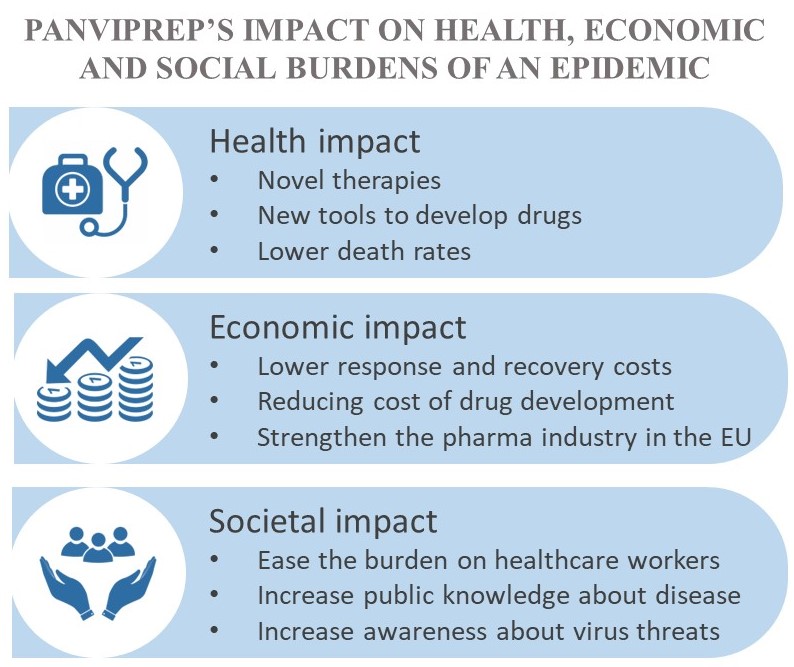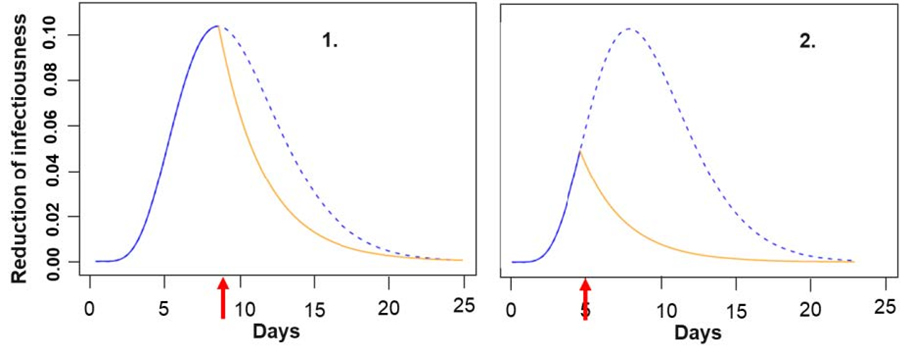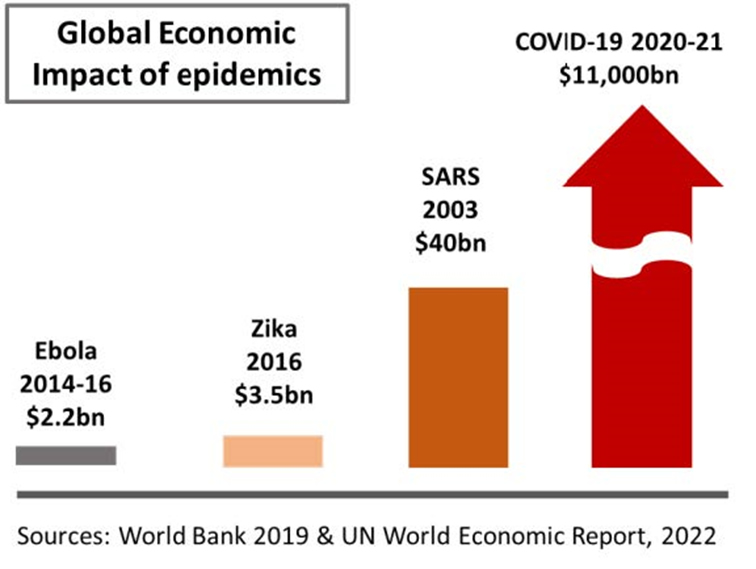Panviprep impact
 PANVIPREP’s longer-term impact includes health, economic and societal impacts, as elaborated below. With “longer-term”, we refer to a timeframe of 5-20 years; consequently, certain forecasts have greater uncertainty.
PANVIPREP’s longer-term impact includes health, economic and societal impacts, as elaborated below. With “longer-term”, we refer to a timeframe of 5-20 years; consequently, certain forecasts have greater uncertainty.
The potential impact of broad-spectrum antiviral drugs
The potential impact of broad(er)-spectrum antiviral therapy in possible future epidemic situations can be illustrated using the recent example of COVID-19. A modelling study by partner KU Leuven on the use of antiviral drugs to control a local outbreak compared the impact of purely non-pharmaceutical interventions (i.e. lockdowns, school closures, cutting inter-city travel and intra-city mobility) to targeted interventions and the treatment with an antiviral drug with moderate potency (i.e., remdesivir). The comparison was based on a simulation model of viral transmission upon implementation of antiviral treatment combined with contact tracing. The study concluded that antiviral drug treatment, in particular when started early (right panel in the figure), may have a major impact on the peak of infectiousness of an infected person. When combined with contact tracing, quarantine and isolation, this will prominently increase the probability that the outbreak will fade out.

Modelled reduction of infectiousness following antiviral drug treatment. The blue and orange lines reflect the infectiousness measure, respectively, before (dashed blue) and after (solid yellow) antiviral administration. The red arrows indicate the start of the antiviral drug treatment (day 8 and 5 day, respectively, in charts 1 and 2). Torneri et al., BMC Med 18, 191 (2020). https://doi.org/10.1186/s12916-020-01636-4
Health impact
PANVIPREP will enable better treatment outcomes by developing specific, effective and safe therapies against communicable viral diseases. The potential contribution will vary per virus group and may in part depend on newly emerging viruses and future epidemic/emergency situations, which may importantly accelerate clinical development (see e.g., the case of nirmatrelvir for use against SARS-CoV-2). Drug development programs for coronaviruses and flaviviruses are ahead of those for the other three virus groups. Yet, based on that experience, substantial progress may be expected for those other groups as well. For PANVIPREP's frontrunners, it should be possible to reach (in a standard (non-crisis) situation) first-in-human studies as early as 2 years after the end of the project.
Economic impact
 The economic burden of a pandemic grows exponentially as the world moves from (proactive) prevention and preparedness towards a reactive response. According to the World Bank, prevention and preparedness costs are about 1% and 3% of response costs. Thus, costs for prevention and preparedness are measured in billions of dollars; pandemic losses can amount to trillions (estimated at $11 trillion for COVID-19). The business-as-usual response to virus outbreaks continues to be based on “contain and control”, after the disease has emerged. Also due to the speed at which emerging viruses can spread globally, this strategy has proven to be both enormously expensive and insufficient. The bulk of the global burden of epidemics/pandemics can be attributed to not (sufficiently) preparing for infectious disease outbreaks. Therefore, research projects like PANVIPREP that deliver adequate prevention and pandemic preparedness tools will generate extraordinary future investment returns. PANVIPREP aims to develop (stockpiled) broadly-acting antiviral drugs to immediately counter any emerging representatives of several high-risk RNA virus families.
The economic burden of a pandemic grows exponentially as the world moves from (proactive) prevention and preparedness towards a reactive response. According to the World Bank, prevention and preparedness costs are about 1% and 3% of response costs. Thus, costs for prevention and preparedness are measured in billions of dollars; pandemic losses can amount to trillions (estimated at $11 trillion for COVID-19). The business-as-usual response to virus outbreaks continues to be based on “contain and control”, after the disease has emerged. Also due to the speed at which emerging viruses can spread globally, this strategy has proven to be both enormously expensive and insufficient. The bulk of the global burden of epidemics/pandemics can be attributed to not (sufficiently) preparing for infectious disease outbreaks. Therefore, research projects like PANVIPREP that deliver adequate prevention and pandemic preparedness tools will generate extraordinary future investment returns. PANVIPREP aims to develop (stockpiled) broadly-acting antiviral drugs to immediately counter any emerging representatives of several high-risk RNA virus families.
Societal impact
Societal impact is the direct consequence of health and economic impacts. Its extent can vary depending on the countries involved and the preparedness of healthcare and societal systems to respond or adapt to emergencies. The availability of antiviral therapy will reduce overall healthcare costs by enabling less intrusive and more effective interventions. It will positively impact the productivity of recovered individuals by improving the quality of care and treatment outcomes. The societal impact of PANVIPREP will be greatly enhanced by providing novel antiviral therapies via national healthcare systems as a strategy to mitigate explosive healthcare cost increases.